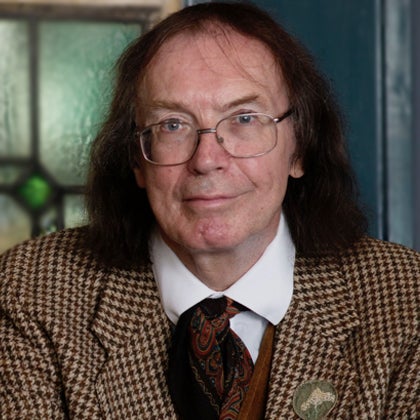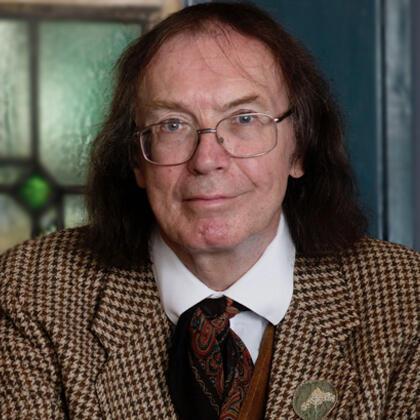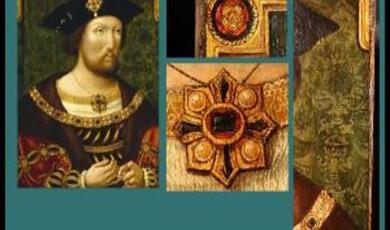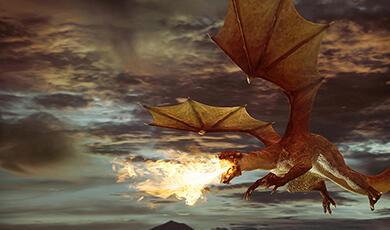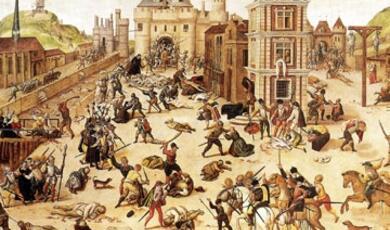Finding Lost Gods in Wales
Share
- Details
- Transcript
- Audio
- Downloads
- Extra Reading
Since the late 19th century, scholars have thought the poetry and stories of medieval Wales, gathered in manuscripts such as the Red Book of Hergest and the Book of Taliesin, represent stories about pagan gods and goddesses – but recently this has been challenged. These books deal with magic and enchantment and contain vivid characters such as Rhiannon, the proud and wilful Arianrhod, the beautiful and treacherous flower-maiden Blodeuwedd, the decent and vulnerable Lleu Llaw Gyffes, and the supreme bard Taliesin.
Download Transcript
Finding Lost Gods in Wales
Professor Ronald Hutton
26th April 2023
The Context of Medieval Welsh Literature
The Welsh were a people born dispossessed. They were the descendants of the original natives of Britain, at the dawn of history, but ended up occupying only a twelfth of the total land mass. Irish adventurers conquered the northern part and turned it into the kingdom of Scotland while the English took two-thirds of the south of the island. For centuries a powerful kingdom survived between, which kept the original British identity and language. The Vikings, however, destroyed that.
So, Wales acquired its identity as a nation in the ninth and tenth centuries. Although still divided into small kingdoms, its people developed a new sense of common character and importance as the heirs of the ancient British. Their survival became that of an entire culture and tradition, with common legends and common heroes, above all, King Arthur.
They was aided in this enterprise by their language, which was unusually well suited to poetry. That may have been because it was developed by poets, the court bards of the sixth and seventh centuries who fashioned it out of the ancient Brythonic tongue. The result enabled just three or four words to convey a set of images or thoughts which would require a stanza in English.
Medieval Welsh tradition credited this achievement to the bards of the sixth century, the greatest of whom was Taliesin. Poems attributed to him have indeed survived in medieval manuscripts. There is however a problem with taking literally the idea that they are the compositions of the legendary sixth-century bard. There is no sign that he was regarded as the preeminent early poet until at least the tenth century. After that, bards claimed to be ‘inspired’ by him, so they wrote in his name, for three hundred years. We are therefore not certain that any of the poems credited to him were composed by him, or even if he ever actually existed. Welsh tradition was so powerful that until the eighteenth-century poets continued to pass off their own work as that of long-dead predecessors: it was simply the fastest way to get respectful attention. Two major problems result, at opposite ends of the chronological spectrum.
The Modern Problem
The modern problem of attribution of medieval texts centres above all on a single remarkable individual, Edward Williams, who took the bardic name of Iolo Morganwg, which just means Glamorgan Teddy. He was indeed from Glamorgan, and was a stonemason, active between the 1780s and the 1820s. He was also a devoted nationalist, part of the great Welsh cultural revival of that period which eventually produced a national literary canon (the Mabinogion), national heroes (like the trickster Twm Sion Catti), a national costume (the steeple hat, dress and cloak worn by Welsh women to this day), a national instrument (the harp), a national symbol (the daffodil) and a national cultural institution (the Eisteddfod). He was a fierce radical in religion and politics, campaigning for the abolition of slavery and of cruelty to animals, and votes for all men. He admitted women as equals to his societies. He was beyond doubt an accomplished poet and visionary, with real courage and imagination, and a great scholar.
He was also a forger, a drug addict, a gaol bird and a charlatan. Some modern Welsh cultural nationalists have equated him in modern Welsh history with the place of Hitler in modern German history. His sincere aim was to aid the contemporary Welsh cultural revival by recovering the ancient wisdom of his people. This he expected to have been embodied in the Druidic system of philosophy which he likewise expected to be a rational and enlightened creed that could be restored for a new age of reason. He further expected that system to have been preserved in the medieval Welsh manuscripts on which he was one of the main experts. On carrying out the necessary research, he realised that it wasn’t there. Rather than give up his dream, he then invented documents himself to fill the gap, containing a system of democracy, humanitarian ethics and reincarnation, with a single benevolent God..
Iolo’s work was taken seriously until the early twentieth century, and all of his forgeries were not exposed until the 1950s. As described, the reaction against him has been vehement. However, his cultural impact on modern Wales has been profound, not least because the ‘Druidic’ ceremonies and organisation that he invented – the Gorsedd of Bards – still open the National Eisteddfod.
The Medieval Problem
The medieval dimension of the problem of attribution starts with the fact that scholars between the late ninteenth and early twentieth centuries believed that certain medieval Welsh poems and stories embody traces of Druidic belief and pagan deities. However, all of these are now thought to be much later than they were formerly believed to be. They date from at least five centuries after the triumph of Christianity, when the native ancient world had practically been forgotten and Welsh literature was full of foreign influences. Indeed, compared with that of Ireland and Iceland, there is actually not much medieval literature surviving. All of it with possible relevance to paganism is found in just four manuscripts written in the thirteenth and fourteenth centuries: the Black Book of Carmarthen, the White Book of Rhydderch, the Red Book of Hergest and the Book of Taliesin. This evidence may be divided into prose tales and poems.
The Material
The Prose Tales
The relevant prose tales were collected in the 1840s under the title – invented for the purpose – of the Mabinogion. This collection consisted of eleven stories from the White Book and the Red Book. None of them are definitely older than the twelfth century. The oldest are probably the Four Branches of the Mabinogi, which from their terminology seem to date from somewhere between 1093 and 1140. Their characters and plots may well be older, but we have no way of telling how old they are. The stories are the work of a sophisticated writer, who drew on motifs from Egyptian, Arab and Indian tales which had been travelling across Europe for centuries.
They have no goddesses or gods as such, unlike medieval Irish and Scandinavian literature, and no characters who are explicitly pagans, even though the Four Branches are apparently set in pagan times. Several of the characters have superhuman powers, but it is hard to tell if this means that they are deities in human form, or simply humans with magical abilities. Two apparent survivals from an older pagan world may perhaps be discerned in the tales. One is shape-shifting, the ability to change the form of objects, turn humans into animals and back and change a human being’s appearance. The other is a place called Annwn, a happy and welcoming Otherworld populated by human-like people, which can interact with the human one. Both are however very general concepts, and no longer linked to pagan deities or beliefs.
The Problem of Deities in Medieval Welsh Tales
The question of how far ‘lost gods’ can be found in medieval Wales, concealed as literary characters, is a complex one. One of the most important and contentious examples is the character of Rhiannon, who is prominent in the Four Branches. There is much about her that seems to indicate that she was a former pagan goddess. The suffix to her name, -on, is one that philologists have argued is associated with superhuman beings in medieval Welsh, and indeed Rhiannon comes from a magical otherworld. She is twice associated with horses, and so some have thought her to have been an ancient British horse goddess. She also marries two successive human princes, and so some have also thought her to have been a goddess who conferred sovereignty.
This all remains possible, but it is also very uncertain. She does not confer kingdoms on her husbands, and there is no clear sign of a sovereignty goddess anywhere in Europe outside of Ireland. There is also no real evidence of an ancient British horse goddess in either Iron Age archaeology or Romano-British inscriptions. Rhiannon herself, in the story, seems much more like a representative of royalty or nobility than a goddess.
Whether we should therefore stop calling her a goddess is therefore a matter for individual choice. It is still entirely possible that she was one, but the decisive evidence is lacking, and it is important to ask instead what characters like would have meant to the medieval Welsh audiences for whom the stories were composed. The Four Branches are ‘about’ friendship, marriage, rulership and feuding, and Rhiannon plays her part in all of those. There is in fact nobody quite like her in previous human literature. She is a being from an enchanted world, who chooses to settle in the human one, and stays even when things go horribly wrong for her. She is propelled by the wish to choose a husband for herself. Thereafter, no matter how bad things get, she never loses control of herself and instinctively produces different correct reactions to differing crises. She always stands her ground with iron willpower and stoical courage. She is, altogether, one of the great female personalities in world literature, precisely because of the way in which she deals with very human situations- and that is her real interest.
The Mystical Poems
The second great body of evidence for possible former pagan characters and motifs in medieval Welsh literature consists of a group of poems. The court poets, or bards, of Wales between 900 and 1300 were the apex of Welsh culture at the time, a highly-trained elite delighting in difficult, allusive verse, packed with metaphor, reference and word play. They were among the leaders of a self-conscious national revival. A key concept in their thought was the semi-divine status of the bard, inspired by awen, meaning the divine spirit of creation. They drew on Irish, pagan Greek and Roman, and overtly Christian literature, but also on earlier Welsh bards, through both written and oral sources.
Seven famous ‘mystical’ poems are credited to Taliesin and could be dated at any time between 900 and 1250. Currently the period 1150 to 1250 is the one favoured for most. They deal in prophecy, fantastic imagery and supernatural themes. In modern times they have repeatedly been mined for traces if ancient pagan wisdom, without any consensus being reached over the results. An absolutely classic example of one is Preiddeu Annwn, the Loot of the Otherworld, which seems to be (among other things) the story of a tragic expedition into a parallel world to bring back a magical cauldron. In its present form it is overtly Christian, composed by somebody who disliked the pretensions of monks to be the greatest scholars, but many have thought that form to be a later addition to an originally pagan text. The truth is that nobody really knows what it means, and the situation is not helped by the fact that there is not even any definite agreement over the precise meaning of about a third of the words in it.
A New Mythology?
Between 1100 and 1400 the court bards seem to have developed new mythological characters or enhanced older characters, as well as possibly preserving some from ancient times. By this process, personalities who started off looking human gradually became more superhuman and similar to divinities. They seem, however, to have been as medieval as King Arthur and Robin Hood. In modern times, reasonably and legitimately enough, their status as deities has been enhanced still further.
One of the greatest of these is Ceridwen. She seems first to appear in the tale called Hanes Taliesin, which was well known by the twelfth century, although the complete version that we have is early modern. She appears in it as a mother skilled in sorcery, who brews a cauldron of potion which will confer the gift of wisdom and inspiration on her son. By accident, her servant Taliesin drinks it instead, and so acquires his mighty talents as a bard. As the brewer of a cauldron of inspiration, she became a great figure for court poets. By the thirteenth century she had grown into the muse of bards, the giver of the power and the rules of poetry. In 1809 a clergyman and antiquarian called Edward Davies made her into the Great Goddess of ancient Britain, an identity which has been accepted by many since.
Another such figure is Gwyn ap Nudd. He appears in eleventh- and twelfth-century texts as one of King Arthur’s warriors. He has some magical powers, but then most of them do. By the fourteenth century poets had turned him into a mighty spirit of darkness, enchantment and deception, a true Lord of the Underworld. In the 1880s an Oxford professor, Sir John Rhys, made him into a Celtic god, and he is often taken as that now.
Another is Arianrhod, who appears in the Fourth Branch of the Mabinogi as a powerful, beautiful and selfish enchantress, capable of making unbreakable curses. By the thirteenth and fourteenth centuries her magical powers had much increased, so that she was able to cast a rainbow around a court, and the constellation in the night sky known as the Corona Borealis had become called the Fortress of Arianrhod. In the twentieth century she became viewed as a star goddess.
The Arthurian Legend
The legend of King Arthur and his companions is the greatest gift that Welsh literature has made to the world. They originated as Welsh heroes and then went on to become international characters. The stories about them also contain what have sometimes been thought to be pagan motifs. The gift of Arthur’s sword Excalibur from a lake, to which it is later returned, might be a memory of the pagan rite of throwing swords, and other precious metalwork, into bodies of water as offerings. On the other hand, it could have been suggested to the composer of the original story about it by finds of pagan swords in lakes and rivers, or even by a persisting medieval custom, in some areas, of throwing a knight’s weapons into such watery places during his funeral procession. The striking of the Dolorous Blow upon a king, which wounds him and so turns his kingdom into a Wasteland, suggests an ancient pagan connection between the physical and moral health of a ruler and the health of his land. On the other hand, the blow is struck with a Christian sacred object, and so the act is one of sacrilege, incurring divine wrath. The Holy Grail has been thought to derive from a sacred Celtic cauldron, like those found as offerings in lakes and bogs. The Grail starts, however, as a dish not a vessel, and then rapidly turns into a Christian chalice.
Finally, in this context, there is Glastonbury, which features prominently in the later medieval Arthurian legend as the Isle of Avalon, Arthur’s refuge and perhaps his burial place. In the twentieth century many have thought it to have been an ancient pagan sanctuary. While it certainly does have remains from the Arthurian period, however, so far none have been found that date from pagan times.
Conclusion
In general, and most frustratingly, medieval Welsh literature as we have it, including the Arthurian legend, faces in only one direction: towards the future. In other words, we can see very clearly how it develops and mutates in later centuries, retaining its freshness and power to inspire in the process. What we cannot see is where it comes from. That may be a problem, but like so many of the gaps in our knowledge of ancient British paganism it can be an inspiration. Rhiannon may be a goddess or not, depending on how you feel. Preiddeu Annwn may plausibly have many different possible meanings. What baffles us as scholars may be a gift to us as artists.
© Professor Ronald Hutton 2023
Further Reading
Davies, Sioned, ed. The Mabinogion. 2007.
Breeze, Andrew. Medieval Welsh Literature. 1997.
Williams, Mark. The Celtic Myths That Shape The Way We Think. 2021.
Hutton, Ronald. Pagan Britain. 2013, pp. 361-70.
Further Reading
Davies, Sioned, ed. The Mabinogion. 2007.
Breeze, Andrew. Medieval Welsh Literature. 1997.
Williams, Mark. The Celtic Myths That Shape The Way We Think. 2021.
Hutton, Ronald. Pagan Britain. 2013, pp. 361-70.
Part of:
This event was on Wed, 26 Apr 2023
Support Gresham
Gresham College has offered an outstanding education to the public free of charge for over 400 years. Today, Gresham plays an important role in fostering a love of learning and a greater understanding of ourselves and the world around us. Your donation will help to widen our reach and to broaden our audience, allowing more people to benefit from a high-quality education from some of the brightest minds.


 Login
Login
